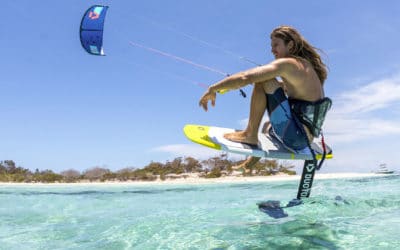The different kitesurfing techniques
Kitesurfing makes you fly over the water, so you may want to do some jumps. But of course, you can’t improvise. So it’s best to learn more about the different techniques that will allow you to make safe jumps.
The simple jump
Let’s start with the basic or simple jump. This is the first one you will learn and you must master it in order to perform the others. There are several steps to this.
The first step is to be on the crosswind with the wing at 45 degrees. Get some speed. Then take a firm grip. At the same time, tilt your body so that the weight is in the heels (to do this, bring your shoulders back). At the same time, you will have to raise the wing to the zenith.
Your wing should be at 12 o’clock at this point. You will then have to keep the pressure on the edge (you will have to resist the pressure of the wing). The hull will come out of the water and you will have to bend your legs. Don’t be ashamed if you look like a toad, this is normal for beginners. As time goes by, you will learn to stretch your front leg for more elegance.
Now it’s time to think about coming down. Even if you like flying, you have no choice. Especially if your wing has passed slightly behind the zenith. You will have to bend both legs and look at the landing area. Then put more pressure on your front hand to accelerate your wing. The contact will be more or less brutal depending on the conditions. Use your knees to cushion the impact. Do not hesitate to shock slightly and remember to pull up your wing.
To make a successful jump, you should not send your wing too hard into the opposite half window. Also remember to notch for enough time. Often this step is too short. To put it simply, it is important to have a good tuck in order to have a good jump. It is also important to take a lot of speed, all the while coming down hard before the edge. Having a suitable sail is also essential. Choose an 8 or 9 m² model.
The transition jump
This jump is ideal for changing direction in style (yes, that counts too!). It may be an easy jump to do, but many people find it difficult. And the reason for this? Simply too much speed, but also too much height. The basic technique for success: take your time.
As far as the timing of the jump is concerned, it is quite similar to the basic jump, but with a little more punch on the take-off.
High wing and low wing jumps
These two jumps are complementary, but it is important to know the difference between them. The high wing jump will keep you high for a long time. It is a very aerial jump. The low wing jump is much lower and requires more dynamism.
For the first one, the material is more important than the technique. Choose a wing with a moderate lift and an optimised hangtime. This will give you better stability. And you can imagine new tricks more easily.
The low wing jump has a horizontal pull. To give you an idea of the result, imagine a wakeboard jump. To get the most out of this style of jumping, technique is the key. You should take it easy. Above all, do small, gentle jumps. This is the best way to progress and become a king in this field.
These two jumps are perfect for intermediate levels.
The strapless transition jump
This jump consists of changing direction when you are in the air. You’ll need to grab your board to position it in the desired direction. The secret? To have excellent support on your board. Other imperatives are to keep your speed low (no need to climb too high), to get upwind when notching, to grab your board behind the front foot, to look (and chest) in the direction you want to go, and to turn your head after the apogee, in order to relaunch the kite more firmly.
Dehooked jumps
Once you have mastered these jumps, you can consider moving on to a higher level. This is where the dehooked jumps come in. Make sure that you have mastered the board and the canopy beforehand and take your time. You will then have to keep your kite at a height corresponding to 11h (not too low). You will have to lower it very slightly in order to reduce the tension in the lines. This will allow you to stall much more easily.
Search
Catégories
Recent Posts
Suivez-nous !














